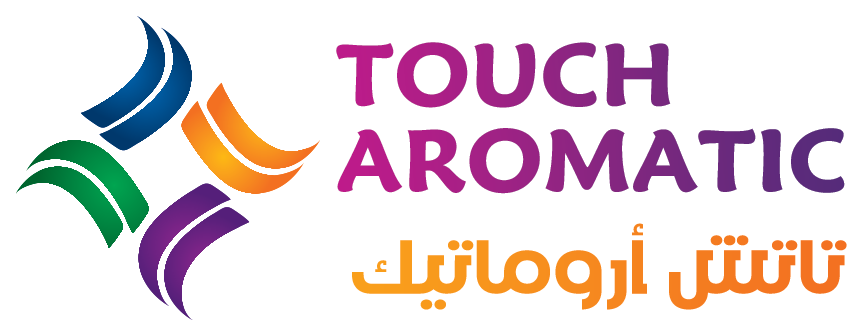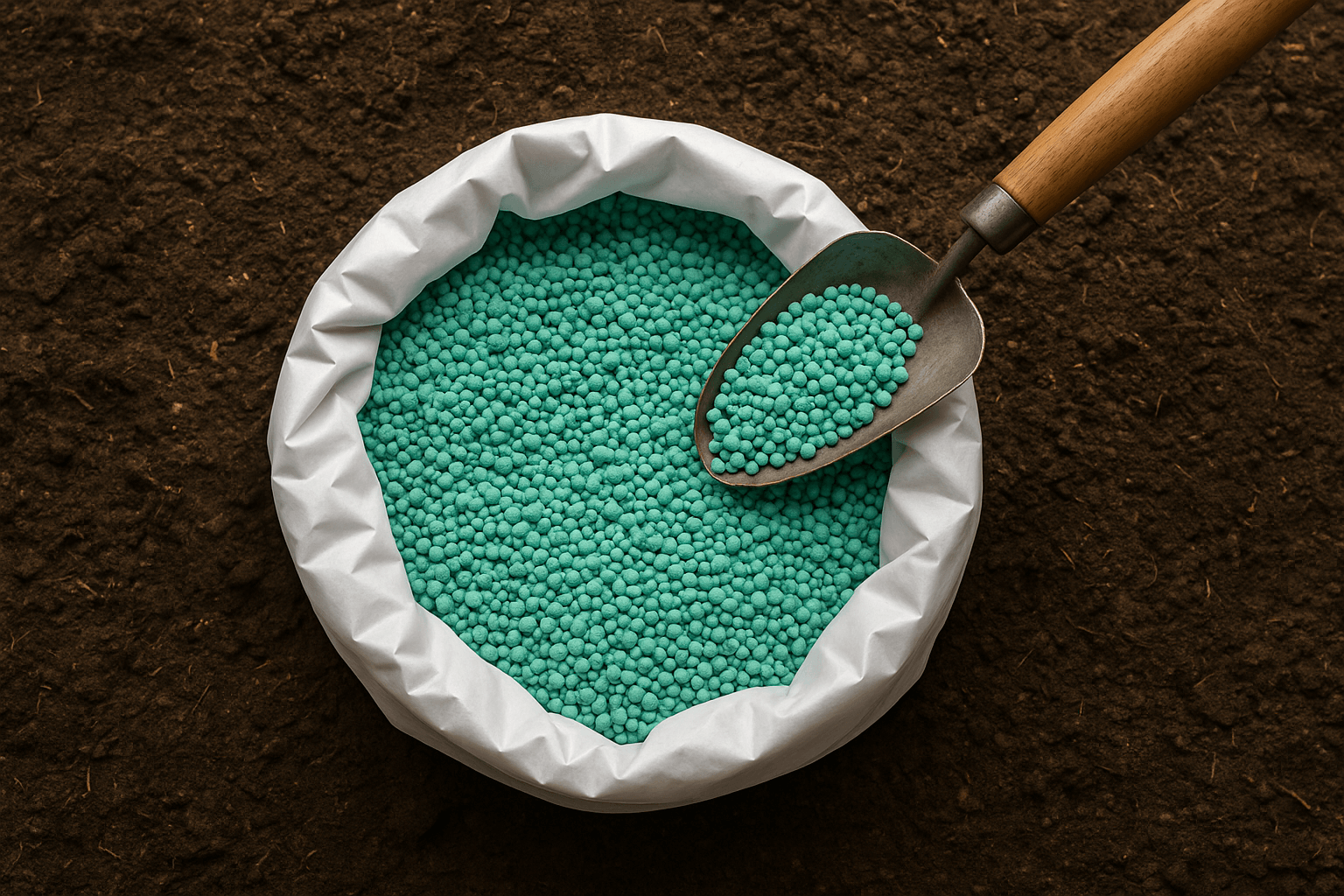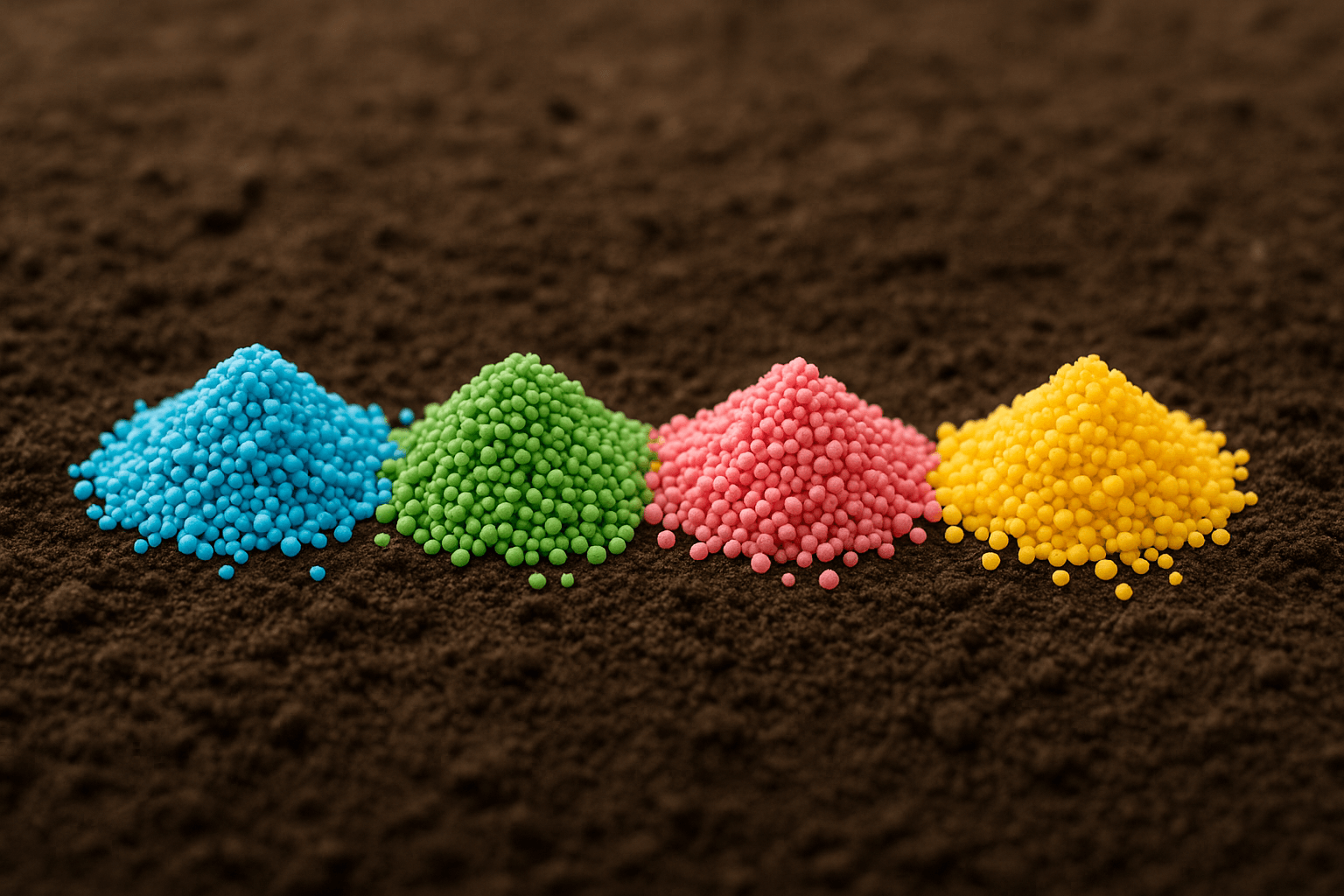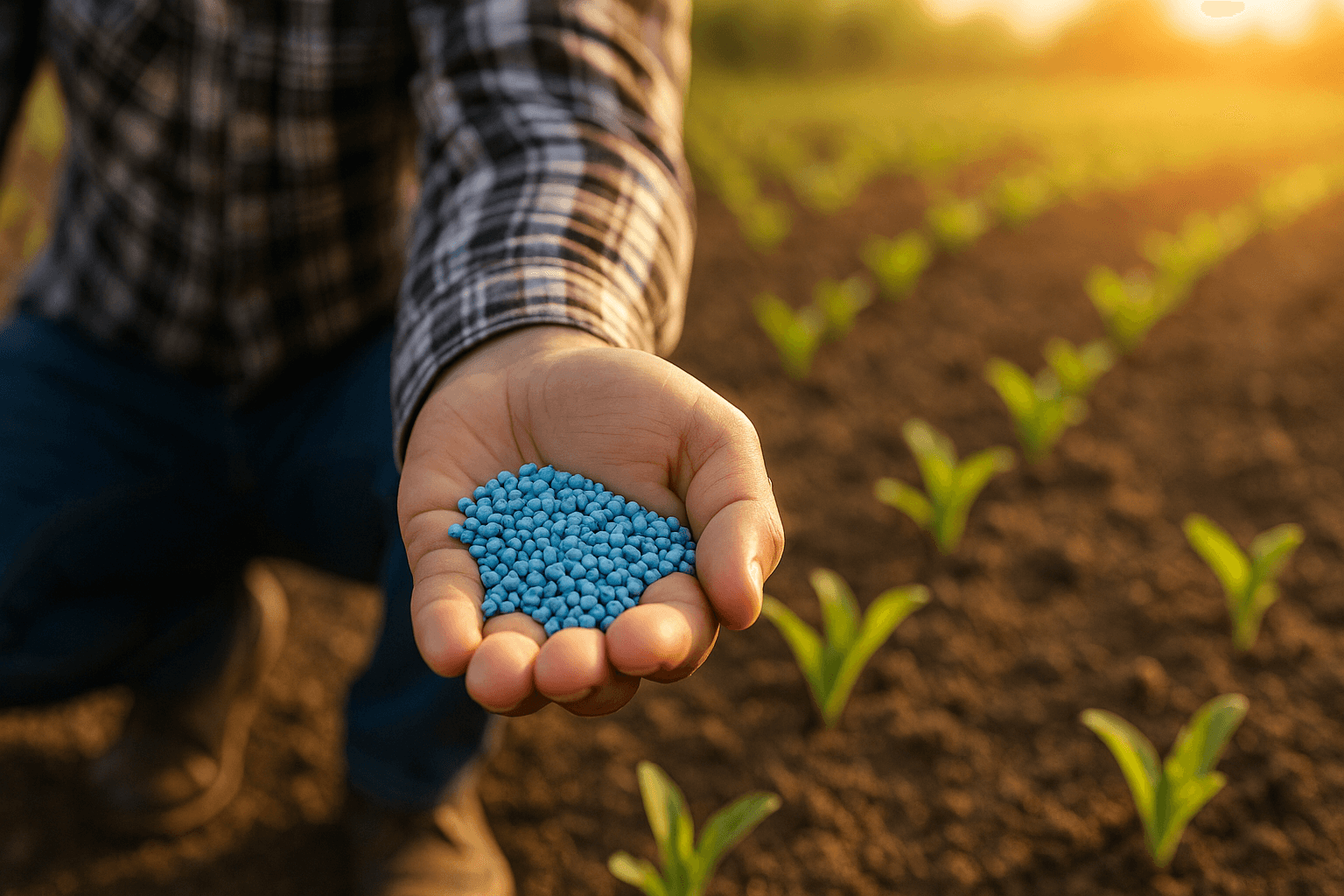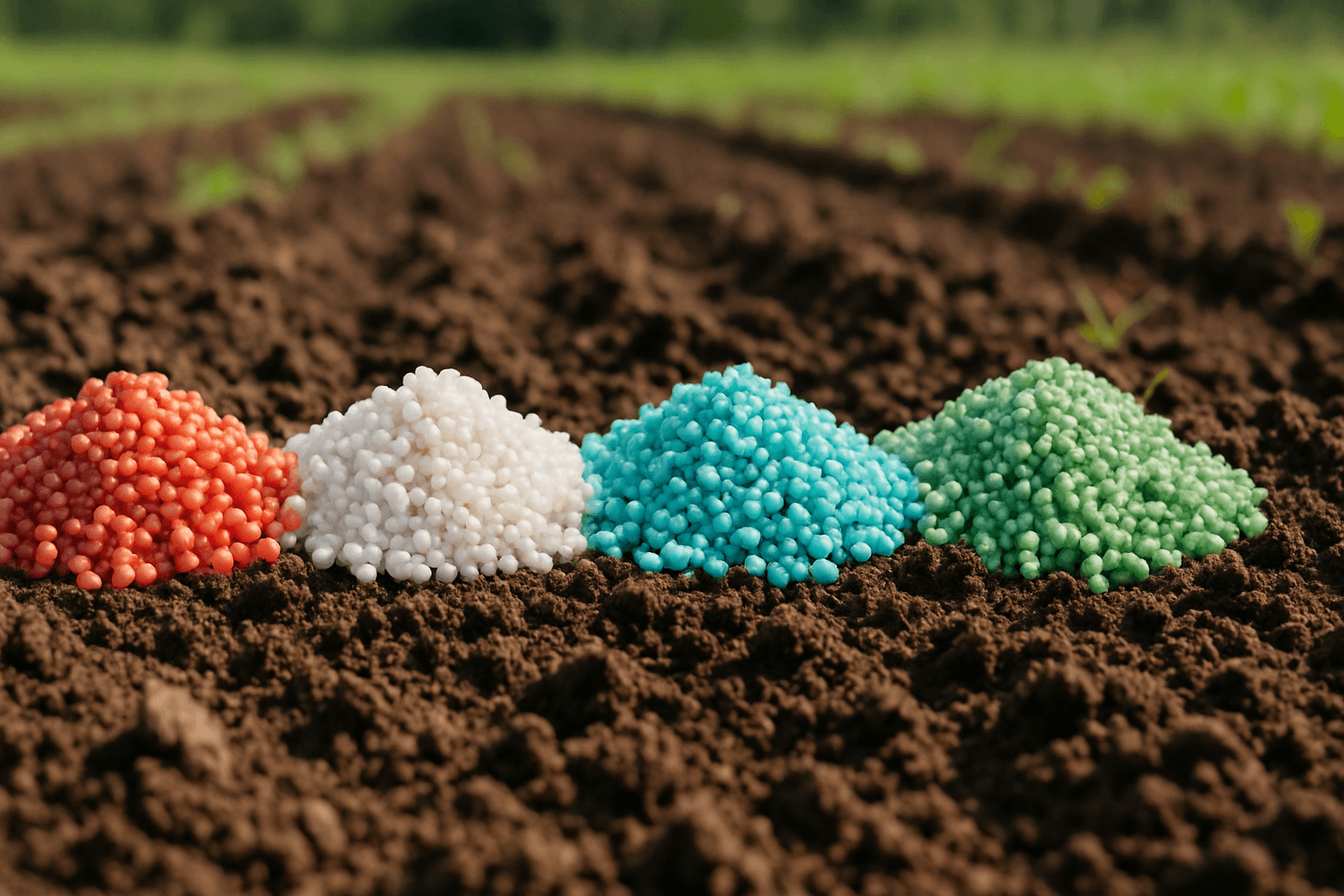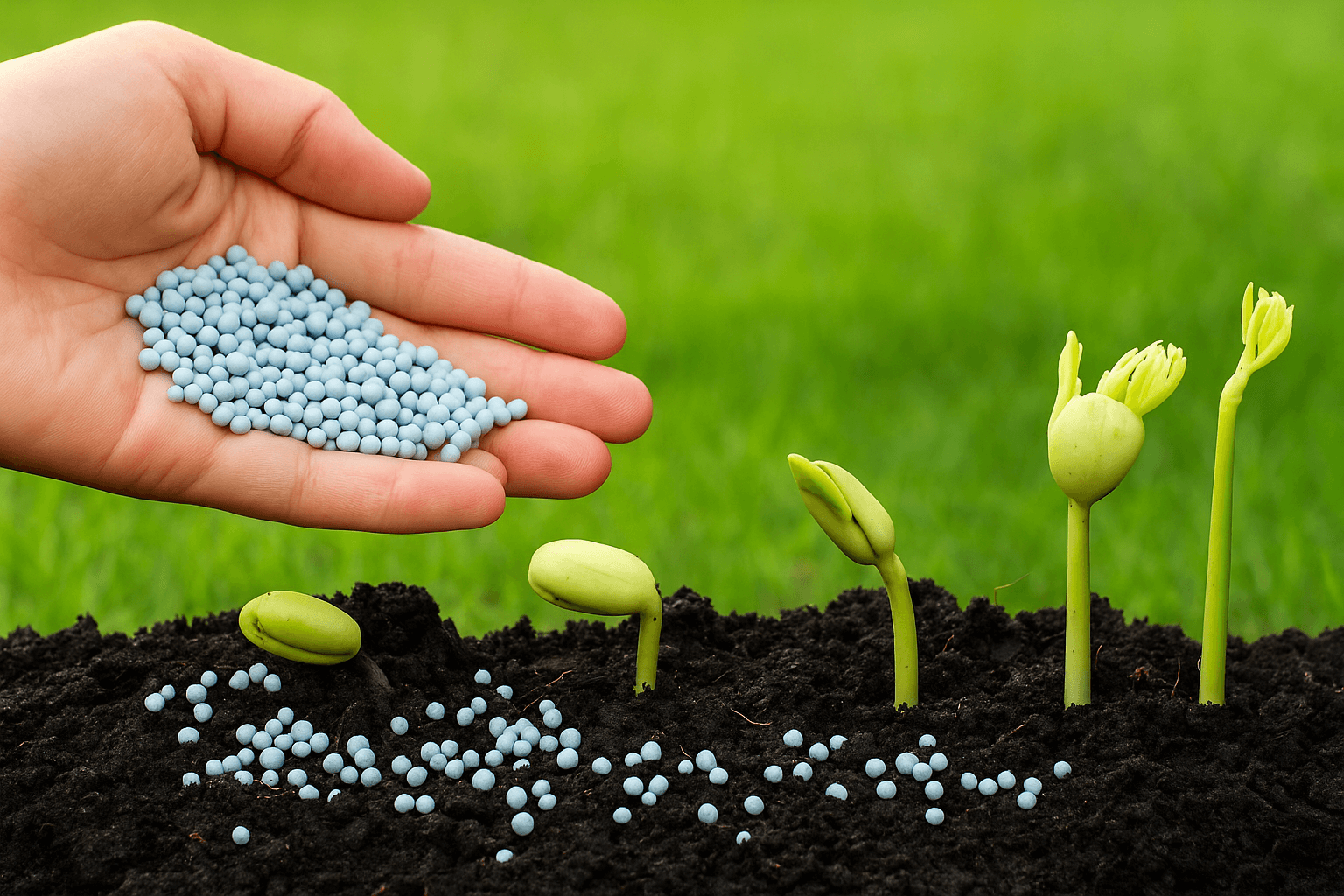What Is the Purpose of Coloring Fertilizers?
When discussing fertilizer production, some may think that adding color is just a cosmetic step with no impact on quality or effectiveness. However, the reality is that this step serves both functional and marketing purposes.
Initially, fertilizers were sold without any distinctive color, which made it difficult to differentiate between different blends—especially in compound or granulated products. As agricultural industries evolved, the need arose to use artificial colors in fertilizers for reasons related to safety, visual identification, and ease of application.
From there, the benefits of colors in fertilizers became increasingly clear—not just to improve product appearance, but also to help it perform certain roles during field application, whether manually or through machines.
Types of Colors Used in Fertilizer Manufacturing
The types of colorants used in fertilizers vary depending on the product type, its chemical composition, and application method. These colors generally fall into two main categories:
Organic pigments: Derived from natural or synthetic organic sources, mostly used in liquid or water-soluble products.
Inorganic pigments: Typically in powder or mineral-based form, added to solid or granular fertilizers.
Some of the most commonly used colors include:
Blue: Often used in nitrogen-rich or highly soluble fertilizers.
Green: Typically used in micronutrient blends like zinc or manganese.
Red or pink: Common in phosphate-based or growth-stimulating fertilizers.
Yellow: Often linked to potassium or sulfur-based products.
Colors are chosen based on several factors including visual product differentiation, easy monitoring of field distribution, and sometimes for branding purposes, like matching with packaging colors or corporate identity.
Benefits of Fertilizer Colors in Practical Use
Colors play an important practical role in modern agriculture. They help enhance user experience, improve application accuracy, and reduce the risk of mistakes during mixing or usage. Below are the main benefits of colors in fertilizers from a practical perspective:
1. Easy Identification of Fertilizer Type
When using multiple fertilizer types on the same farm, it's much easier to distinguish between different blends by visual color cues.
A grower or farm technician can quickly identify a high-nitrogen blue fertilizer from a green micronutrient one without having to read every label.
2. Visual Monitoring During Spreading or Spraying
Colored fertilizers allow users to visually track distribution on soil surfaces or crops—especially during surface broadcasting or manual spreading. This helps:
Avoid overlapping or double application
Ensure uniform coverage
Evaluate application effectiveness in real time
3. Reduced Errors During Mixing or Blending
In fertilizer mixing plants or when preparing spray solutions, product colors help prevent accidental blending of the wrong formulas—especially when products look similar in texture.
Having distinct colors allows users to immediately spot any error in the mixture before it’s used in the field.
4. Easier Training for New or Seasonal Workers
In large agricultural companies or during seasonal operations, new workers often join the team.
Using colored fertilizers helps train them faster, as each color can be linked to a specific use or crop—reducing the learning curve and improving execution accuracy in the field.
Benefits of Fertilizer Colors in Marketing and Distribution
While the primary purpose of adding colors to fertilizers may be functional, it also has a powerful impact on the marketing and distribution strategy of any agricultural product. In a competitive market filled with similar offerings, color plays a central role in attracting attention, reinforcing brand identity, and simplifying the purchasing decision—whether for a wholesaler, retailer, or farmer.
1. Enhancing Product Visual Identity
When each fertilizer type has a unique and consistent color, customers can easily recognize it at a glance. For example:
Some companies use dark green for all their organic product lines.
Others mark nitrogen-rich blends in blue, phosphorus in red, and potassium in yellow.
This visual consistency makes the product stand out on the shelf and reduces the chance of it being confused with a competitor—especially in markets where label reading is less common.
2. More Effective Promotion in Marketing Campaigns
Colored products are easier to showcase in catalogs, agricultural expos, and visual ads. Instead of a plain white bag, you can display a bold, vibrant product that looks professional and suggests strong field performance.
Some brands even use color as a direct marketing tool with slogans like:
"Blue fertilizer… Faster growth. Bigger yields!"
In this case, the color becomes a selling point in itself.
3. Improved Distribution Organization and Inventory Speed
In large distribution networks—especially during peak agricultural seasons—chaos can arise in sorting shipments and managing stock.
But when each product has a unique color, it becomes much easier for warehouse teams and drivers to identify what’s needed, without opening bags or reading every label.
This leads to:
Fewer delivery errors
Faster loading and dispatch
Better customer experience at delivery
4. Building Brand Loyalty
When farmers associate a specific color with a successful crop outcome, that color becomes a point of trust.
A farmer who achieved excellent results using a blue fertilizer last season will likely ask for it again—using the color as a reference, even if they forget the brand name.
Thus, color becomes a tool for customer loyalty, sometimes more powerful than expensive ad campaigns.
Do Colors Affect Fertilizer Quality?
This is a common question from both farmers and distributors: Do colors in fertilizer affect its performance or composition?
The accurate answer is no—colors in fertilizers do not add nutritional value, but they also do not reduce the effectiveness of the product when used properly. However, it’s essential to distinguish between regulated color usage and the random addition of unapproved dyes.
1. Colors Do Not Alter Chemical Composition
The added color—whether powder or liquid—does not react with core elements like nitrogen, phosphorus, potassium, or micronutrients.
Its role is purely visual identification, and it has no direct impact on absorption or the fertilizer’s function in the soil.
This means that the benefits of colors in fertilizers are not about performance enhancement but rather about product usability, safety, and clarity.
2. Quality Depends on the Type of Pigment Used
While color doesn’t influence nutrient delivery, choosing the right type of pigment is critical to avoid unintended issues.
For example:
Only non-toxic, agriculture-grade pigments should be used.
Industrial dyes must be chemically stable, and should not react with moisture or high temperatures.
Poor-quality or inappropriate pigments can cause soil contamination or clogging in drip irrigation systems.
Therefore, manufacturers should list the type and percentage of pigment clearly in the product’s data sheet as part of standard agricultural safety practices.
3. Excessive Coloring Can Create Application Issues
Sometimes, manufacturers try to intensify a product’s color for marketing reasons by increasing pigment concentration. This can cause several problems, such as:
Staining of mixing equipment or sprayers
Leaf spotting during foliar application
Overly colored soil, which may concern farmers
That’s why it’s important to keep coloring within balanced and practical limits—just enough to identify the product without causing operational issues.
4. Proper Coloring Reflects Manufacturing Quality
Consistent coloring across batches, with even distribution and known pigment sources, signals strong quality control and a professional production process.
In contrast, color variations between identical bags may indicate poor manufacturing standards or unstable pigments.
How to Choose the Right Color for Each Fertilizer Type
Choosing the right color for fertilizer isn’t a random decision—it’s part of a technical and marketing strategy aimed at improving product clarity, ease of use, and differentiation in the market. Color becomes an essential element of a fertilizer’s identity.
1. Linking Color to the Active Ingredient
In many cases, a specific color is associated with a particular nutrient to make it easier to identify in the field. For example:
Blue is commonly linked to high-nitrogen or water-soluble blends meant for leafy growth.
Red or pink is often used for phosphorus-rich fertilizers that promote root development and flowering.
Yellow typically indicates potassium or sulfur-based formulas.
Green is associated with micronutrients like zinc or manganese, or with eco-friendly products.
This connection between color and content helps farmers and technicians understand the fertilizer’s purpose at a glance—even before reading the label.
2. Based on Target Crop
Some companies select colors depending on the crop the fertilizer is designed for. This allows them to create a product series tailored to each plant type.
Examples include:
Orange packaging for tomato-focused formulas
Brown for fertilizers intended for palm trees
Olive green for blends suitable for olive cultivation
This approach supports marketing efforts and helps farmers make quick purchase decisions.
3. Environmental Conditions and Application Method
Environmental factors may affect the choice of color:
In desert regions with intense sunlight, dark colors (like black or navy) may retain too much heat, which can affect product stability.
In dark soils, dark-colored fertilizers may be hard to see during manual application, so lighter tones like yellow or pink are used instead.
Also, fertilizers applied through drip irrigation or spraying systems should contain fully soluble and clean pigments to prevent clogging or residue buildup.
4. Brand Identity Consistency
Some agricultural companies adopt a unified color scheme across their product lines as part of their brand identity.
In this case, the product’s interior color is matched to the packaging and company colors—provided this doesn’t compromise usability or cause confusion in the field.
Global Market Trends in Colored Fertilizers
With the evolution of agricultural industries and the rise of modern farming practices, colored fertilizers have become increasingly prominent in global markets—not just for visual appeal, but as a reflection of organization, professionalism, and ease of use. Today, the benefits of colors in fertilizers are seriously considered by manufacturers, distributors, and farmers alike.
1. Colored Fertilizers as a Quality Indicator in Advanced Markets
In European and North American markets, fertilizers with distinctive colors are often seen as higher quality by farmers because:
Color indicates systematic and consistent manufacturing
It helps with field application tracking over large areas
It gives the impression that the product is carefully formulated and tested
Some certification bodies even encourage color-coding in fertilizers to minimize user errors with similar-looking products.
2. Growing Demand for Natural and Non-Toxic Colorants
As global agriculture shifts toward more eco-conscious practices, manufacturers are expected to use natural or organic colorants, especially in products aimed at organic farming or export markets.
This has led producers to:
Replace synthetic dyes with plant-based or mineral-based pigments
Conduct toxicity tests on added colors to ensure environmental compliance
Market their products as safe for soil and water ecosystems
3. Rising Competition in Product Design and Packaging
Fertilizers today are sold not just by specification but also by appearance. As a result, color has become a marketing tool, helping products:
Stand out at agricultural exhibitions
Capture attention in advertisements
Reinforce the brand’s visual identity
At some international expos, entire sections are dedicated to showcasing “smart fertilizer packaging,” where color plays a central role.
4. Future Expectations
With technological advancements and changing consumer behavior, it’s expected that colored fertilizers will:
Expand more widely in emerging markets across Africa and Asia
Be paired with AI-based tools to recommend the best color based on product type
Become part of visual barcode systems to streamline logistics and quality control
This evolution shows that the benefits of colors in fertilizers go far beyond aesthetics—they’re quickly becoming essential in traceability, efficiency, and even smart agriculture.
| Conclusion
Using colors in fertilizers is no longer just a visual detail—it has become an essential feature that serves multiple functions. From product identification and field application accuracy, to enhanced branding and streamlined distribution, colored fertilizers add clear value.
While colors may not offer direct nutritional benefits, they’ve grown into a strategic component that impacts user experience, farmer trust, and agricultural efficiency.
As the market continues to embrace smart, sustainable farming, colored fertilizers are set to play an even bigger role in shaping how we manage and deliver agricultural solutions.
